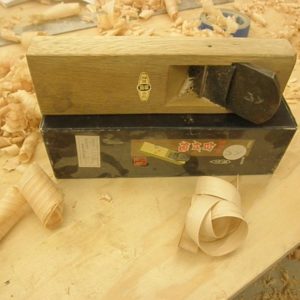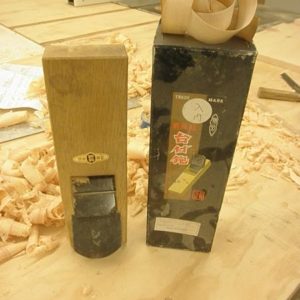To all you hand tool guys,
While sorting though some stuff in my shop I rediscovered an old box with Japanese characters and then I remembered there was a plane in that box. Sure enough when I opened it I remembered the wood block plane that I must have purchased thirty plus years ago and was still unused, I’d forgotten I had it.
I took it out of the box and looked it over. Its very simple. The block of wood is some kind of white oak, a little smaller than a 2 x 4 and about 8″ long. Realizing I had no idea how to use it didn’t stop me. I wanted to put a fresh edge on the iron and remove the small amount of rust that had formed on it. There are only four parts to this tools which I’m sure I’m calling the wrong names, The wood body with a very nicely hand cut opening for the iron, the iron which is thick laminated steel, the chip breaker and a metal pin that holds the metal parts in the body.
I removed the chip breaker with a specialized tool (flat blade screw drier) but the iron was firmly wedged into the wood body. I remembered something about tapping on these planes with a brass mallet which I don’t have so I clamped the iron in my woodworkers vice edge-wise with the plane upside down and tapped the back of the plane with a wood mallet, nothing moved. I tried tapping with various implements and was finally successful using a 22 oz. smooth faced framing hammer. It was very tight!
The iron is a nice thick hunk of laminated steel on which I was able to get a very sharp edge using some ceramic Japanese wet stones. I was thinking of working on the throat of the wood body so the iron wasn’t so tight but decided against it seeing as friction is the only thing holding it in place. I tapped all two pieces back in place and tapped the cutting edge out the bottom of the plane what seemed the appropriate distance for making a nice cutting pass.
I had a 6′ piece of 4/4 cherry that I had edged on the joiner and I clamped in on edge in my bench vise. I carefully began my cut at one end and to my amazement produced a perfect unbroken ribbon of cherry wood which I carefully uncoiled and sure enough It was all 6′ long and 15/16″ wide and a couple of thousandths thick. Wow, where has his tool been all my life, Oh yeah, stuck in a drawer behind a bunch of old stuff for thirty years.
So I spent another hour or so planing everything in sight. Did alot of nice camphoring and smoothing. This thing cuts end grain better than any other tool I’ve ever used. I was planing just for the sake of planing and thoroughly enjoying it. This would seem weird to most normal people but I’m sure all you other woodworkers understand completely.
Now tell me all the things Ive done wrong, please. I want to learn more about this tool.
thanks, Bret
















Replies
I always understood that these planes were to be pulled rather than pushed but the other day FWW had a video of Garrett Hack (I think it was) with a Japanese plane maker using one of his planes and after he made a beautiful pass on the pull stroke, GH made one by pushing in the western tradition. Didn't seem to make a difference. Now I want one.
"Now tell me all the things Ive done wrong" - - - you waited 30 years to try it out... don't do that.
EDIT Just looked it up, it was GH. Also found a great piece by Carl Swensson in Fine Woodworking #145. No relation.
aging one's tools
I understand that most Japanese toolmakers age their components. My Japanese chisels were cheap ones - the handles were advertized as having been aged for only 10 years. So, I suppose leaving your plane in the drawer for 30 years might be a reasonable substitute. ;-)
Now that you've been indoctrinated (aka infected) in Japanese planing, you'll need to modify your shop garb. In another 30 years, you may be able to work your way up to a black belt. ;-)
Could be why it cut so well for me, I've aged it to perfection.
I guess I'll go down to the tool cellar and rotate my chisels. Ha Ha.
Bret
A number of the Japanese tools imported 20 to 30 years ago were made by individuals who are now highly regarded and those tools can be quite valuable. It'd be good to check one of the web forums dedicated to Japanese tools and post some images where people can see logos, packages or other identifying features.
"Kanna"
LW,
Your comment got my attention. I learned that a Japanese wooden hand plane is known as Kanna and indeed some of them are quite valuable.
I could not find one like mine on any site yet. I'll keep looking and let you know what I find out. My suspicion is that I do not own a masterpiece but I'll let you know what I find out.
Thanks for the heads up, Bret
you might try asking at
http://www.shizutanischool.org/phpBB3/
Bret,
If you want to learn more about the subject, there's a great book called "Japanese Woodworking Tools: Their Tradition, Spirit, and Use" by Toshio Odate. As the subject implies, it deals with the mindset and training of a Japanese craftsman as much as the actual use of the tools.
http://www.amazon.com/Japanese-Woodworking-Tools-Tradition-Spirit/dp/0941936465
To release the iron of a wooden plane, you can either knock the heel of the plane at the back, or commonly, with Japanese planes, the top of the heel (behind the blade), where you would expect the tote to be. That should losen the wedge.
I''l take a look at the book
Thanks for the link Chris.
Bret
If your in the San Francisco Bay area Jay Van Arsdale http://www.daikudojo.org/index.html teaches a class at Laney College on Japanese hand tools, he covers planes extensivley. He also has a lot of neat stuff on his website. I was taking a woodworking class from another instructor and he did a little sharpening demo and afterwards I got to use one of his chisels and was able to see the difference between what I thought was sharp and what was sharp, just that little demo really made an impression. Good luck with your "new" plane.
Troy
This forum post is now archived. Commenting has been disabled